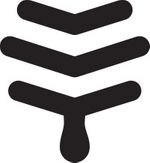Watch Facebook Live: What type of brood frame is best?
The timber brood frames that come with our Flow Hives can be used in 4 different ways:
1. Foundationless frames
Assemble the frame with some glue and the supplied nails. Glue or nail the provided timber strip into the slot in the top bar of each frame to act as a comb guide – they are now ready for your hive. The comb guide sets the starting point from which the bees draw out natural comb.
Four tips for successfully using foundationless frames:
- When you add them to your brood box, press the frames tightly together so that the spacing is correct for the bees to start their comb. Leave any excess space towards the edges of the box.
- Make sure the hive is flat and level horizontally (ie: from side to side direction) so that as the bees build comb it is more likely to hang inside the frame.
- If you are starting from scratch with a new colony and empty brood frames, inspect the brood once a week to make sure they are building comb on the guides to avoid cross comb. If the comb starts to wander off the guide, push it back into place with your hand or hive tool. Generally, once your bees build a few straight combs, they will continue to do so on the remaining frames.
- When inspecting fresh foundationless comb, keep the frame vertical. Fresh comb is very delicate, be careful not to tilt the frame in such a way that the comb will break off.
Foundationless frames are becoming increasingly popular and have many benefits. For more information check out this great blog post 'Foundationless brood frames' by Hilary Kearney.
Watch: Starting a Flow Hive with foundationless frames
2. Starter strips of wax foundation
This is a similar method to the foundationless frames method outlined above, but instead of using a wooden strip as a comb guide, you use a 20 mm wide strip of wax foundation* to give the bees a starting place for their comb. Melted beeswax can be used to stick the wax strip into the slot in the top bar.
3. Wax foundation
Use a full sheet of wax foundation* and mount it into the frame. To do this you will need to thread wire through the holes in the sides of the frame in order to support the wax. Once the wire is tightened it is usually electrically heated to melt it into the wax foundation sheet. This method gives the bees a sheet to start on so it will be less important to check that they are building straight comb, although they will still build wonky or ‘off-square’ sometimes.
4. Plastic foundation
Use a prefabricated sheet of plastic foundation* and assemble the frame around the plastic foundation. You do not need the wooden strip comb guides for this method. It’s less important that the hive is level in this case, but it’s still a good idea to make sure it’s sitting fairly flat and level. Most beekeepers rub beeswax on plastic foundation as the bees will take to it more quickly.
*Wax foundation and plastic foundation sheets can be purchased from a commercial beekeeping supply store.
“Beekeepers have many opinions on which is the best method. I am a total convert to foundationless frames. It’s a really tedious task waxing and wiring frames. It’s so much easier to let the bees build their own. It leaves the bees making their natural cells sized perfectly for their brood and it’s beautiful to watch them hang their natural comb in their brood nest.
Having said that, in some short-season regions it is important to encourage the bees to get to the nectar flow as quickly as possible. It may be better to provide wax foundation as the bees will complete their brood comb more quickly.”
– Cedar
Beginner Beekeeping Ep 3 - Setting up brood box frames
Want to learn more? Our online beekeeping course features advice from the world's experts, and the free trial includes information on brood frames and foundationless beekeeping. Find out more.
Need extra timber frames?
Spare timber brood frames are always handy to have – whether you’ve captured a swarm, are performing a hive split or just need to swap out some frames for routine maintenance. Check out our timber Foundationless Brood Frames here.




